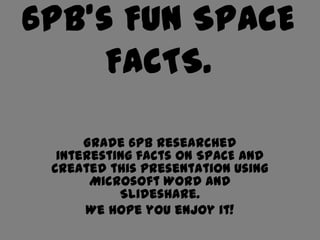
6PB's Fun SPACE FACTS Presentation
- 1. 6PB’s Fun SPACE FACTS. Grade 6PB researched interesting facts on SPACE and created this presentation using Microsoft WORD and Slideshare. We hope you enjoy it!
- 2. The MilkyWay The Milky Way is approximately 100, 000 light years in diameter. Our Milky Way Galaxy contains anywhere from 200 to 400 billion stars. What we can see from Earth is only a tiny amount of the stars in the Milky Way. Bibliography: Picture: http://www.universetoday.com/75691/how-big-is-the- milky-way/ Information: http://www.universetoday.com/21563/milky-way / By Olivia and Antonia
- 3. Space debris Space debris is a mix of either old or useless satellites or satellites that never worked . The gravity from earth will eventually pull all of the space debris down to earth. No one has ever been killed from space junk falling to the ground though. Bibliography: Pictures: http://commons.wikimedia.org/wiki/Space_debris Information:http://science.nationalgeographic.com/science/space/solar-system/orbital/ By Gabby, Blake and Evan
- 4. Sound in Space Sound travels through the air, so on Earth people can hear others voice because the sound travels with the air unlike space. Space has no air so the sound can’t travel. Bibliography: http://www.qrg.northwestern.edu/projects/vss/docs/space-environment/1- is-there-sound-in-space.html By Erica and Rosie
- 5. Animals In Space Not just monkeys, cats and dogs went into space, but crickets, spiders, frogs, ants, Japanese killfish and fish newts are all creatures that have travelled into space. Bibliography: http://www.space-explorers.com/internal/events/trivia/dyk2.html http://commons.wikimedia.org/wiki/Animals_in_space By: Elysia, Giorgia and Imogen!
- 6. Galaxies Galaxies are a massive group of stars, gas and dust. the sun and the solar system are part of the Milky Way galaxy. There are probably more than 170 billion galaxies in the universe. even in the milky way galaxy there are still lots more planets to be found..................maybe (: Scott and James Bibliographyp://en.wikipedia.org/wiki/Galaxy http://en.wikipedia.org/wiki/Galaxy
- 7. Stars The sun is the closest star to earth and it can fit into the biggest star about a million times. A small star lasts longer than what a big star would last. A big group of stars are called galaxies. A star is made when a massive cloud of hydrogen gas collapses until it is hot enough to burn nuclear fuel. All groups of stars are held together by gravitational forces. Bibliography: http://www.universetoday.com/25145/interesting-facts-about-stars/ http://www.enchantedlearning.com/subjects/astronomy/stars/ By Antonina and Natalie
- 8. THE FIRST LAUNCH INTO SPACE The Apollo 11 launch date arrived with just months to spare on July 20, 1969. Nine years earlier U.S. President John F. Kennedy had said that by the end of the decade the country would put a man on the moon and return him safely to Earth. In April 1961 the Soviets sent the first human to space. Russian cosmonaut Yuri Gagarin made a 108-minute suborbital flight in a By Vostok 1 spacecraft and By Nick, Nathan and Paul & MrsMelenhorst returned safely to Earth. Bibliography: WWW.NASAhistory.com
- 9. SPACE SHUTTLES NASA's space shuttle fleet began setting records with its first launch on April 12, 1981. The final space shuttle mission, STS- 135, ended July 21, 2011 when Atlantis rolled to a stop at its home port, NASA's Kennedy Space Centre in Florida. Bibliography: http://commons.wikimedia.org/wiki/File:Enterprise_free_flight.jpg http://www.nasa.gov/mission_pages/shuttle/main/index.html BY MAT AND CORRIE
- 10. The moon. The Moon is the second brightest object in the sky after the sun. The Moons surface is like powder, which is called regolith. It is 100% dry. The Moon is about 238,900 miles (384,000 km) away from Earth. Bibliography- http://www.bobthealien.co.uk/moonwelcome.htm http://commons.wikimedia.org/wiki/File:Moon_merged_small.jpg http://en.wikipedia.org/wiki/Moon By Tarsha, Emily, Kara
- 11. Women In Space • The first woman in space was a Russian by the name of Valentina Tereshkova. On the far side of the moon there is a crater that is named after her! The year in which she landed was 1963. She was awarded many rewards and prizes and special honours afterwards. • In 1991 a woman by the name of Helen Sharman spent 18 months training before she finally was able to go to space. She spent eight days there conducting experiments. Bibliography- www.spacekids.co.uk/spacehistoy/ By: Ellen and Joanne
- 12. Asteroids Almost all of the asteroids in our solar system orbit in a group between Mars and Jupiter. This is called The Asteroid Belt. Some scientists believe that our solar system’s asteroids were formed when a planet that existed years ago exploded or collided with another planet. Other scientists think that the materials the asteroids are made of never came together to form a planet at all. Bibliography: www.qrg.northwestern.edu/.../2-how-asteroids-orbit.html By: Thomas & Thomas www.commons.wikimedia.org